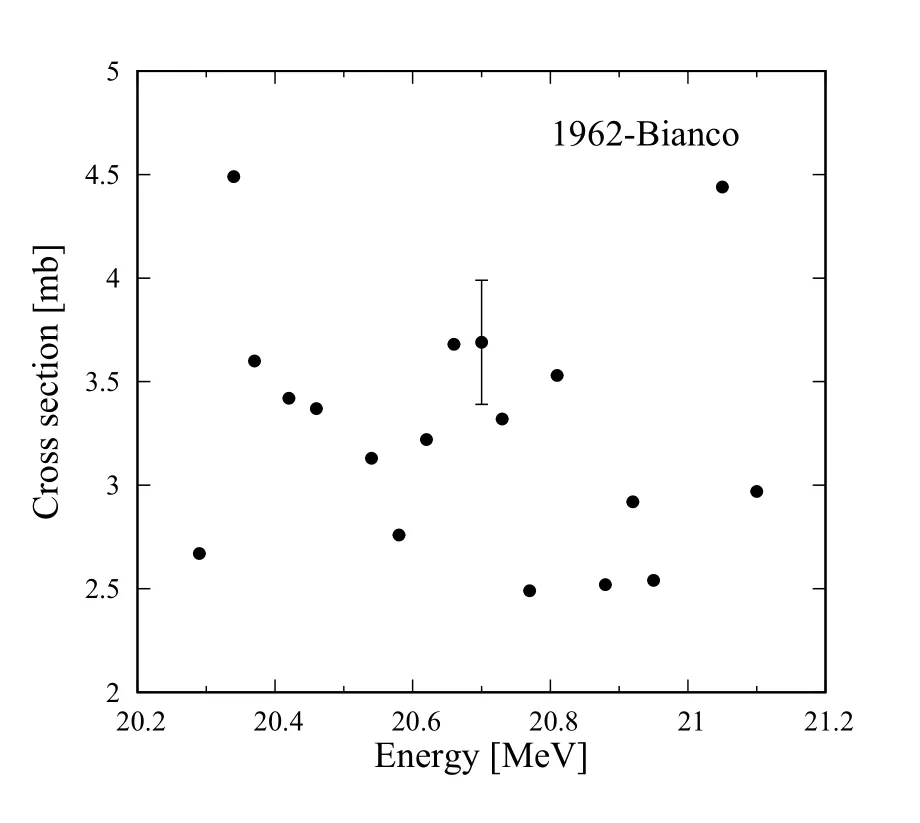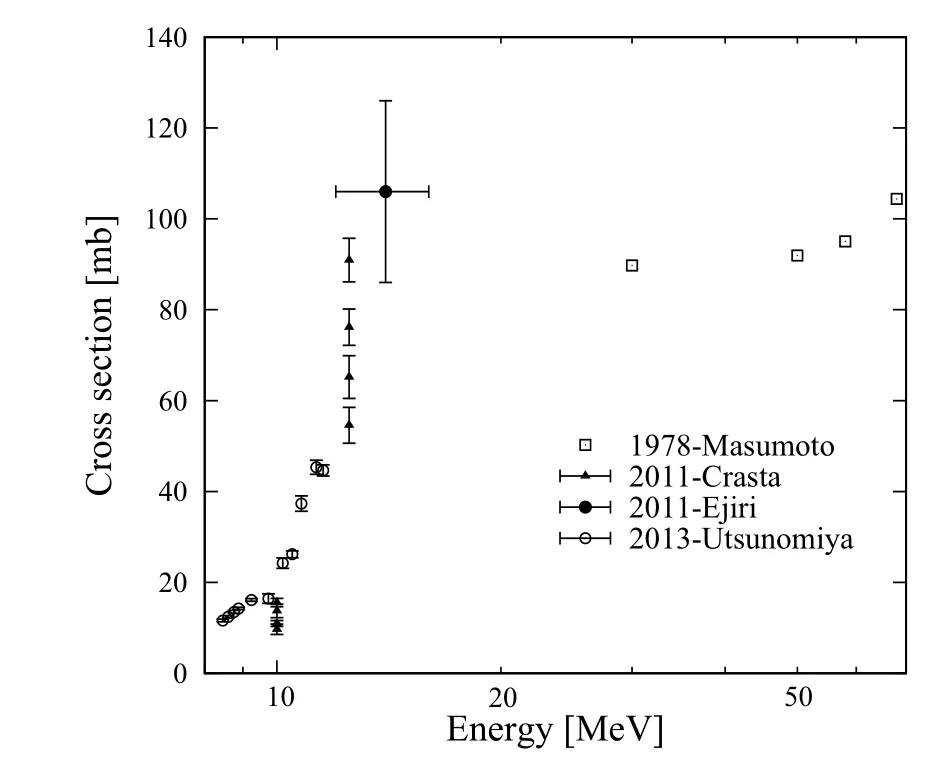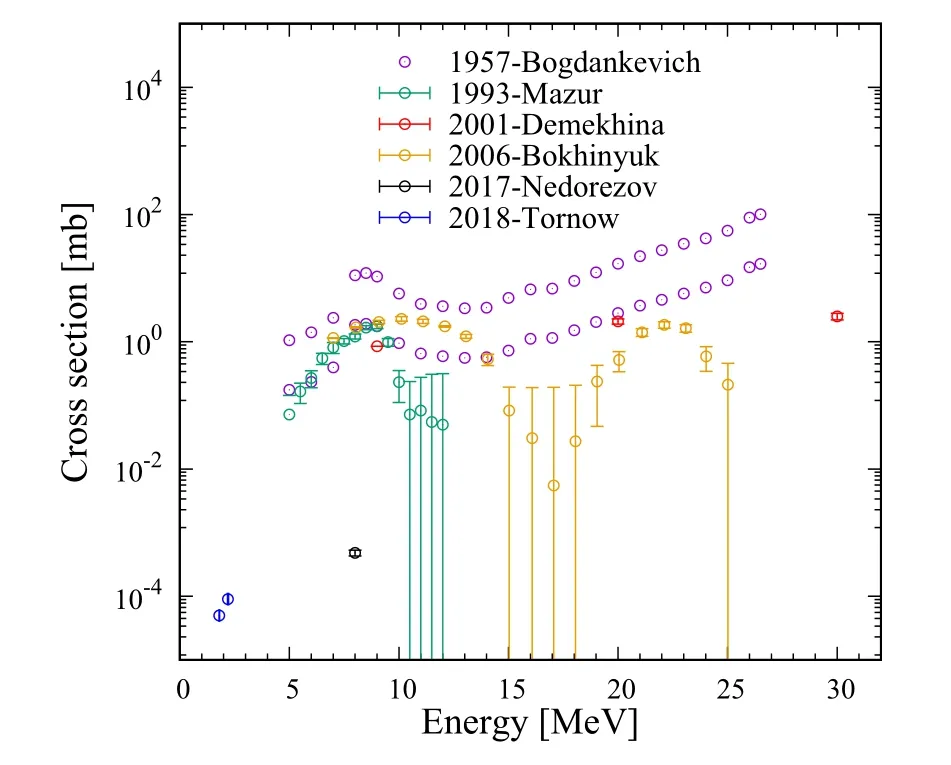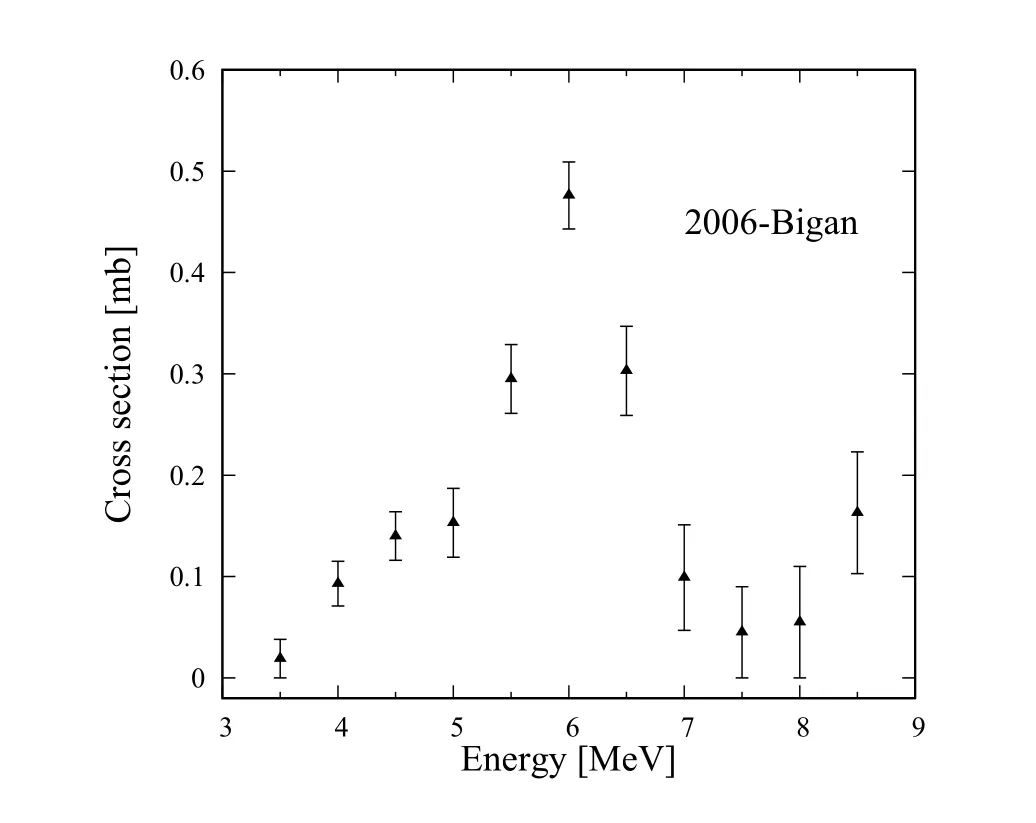Progress of photonuclear cross sections for medical radioisotope production at the SLEGS energy domain
Xuan Pang · Bao-Hua Sun · Li-Hua Zhu · Guang-Hong Lu · Hong-Bo Zhou · Dong Yang
Abstract Photonuclear reactions using a laser Compton scattering (LCS) gamma source provide a new method for producing radioisotopes for medical applications.Compared with the conventional method, this method has the advantages of a high specific activity and less heat.Initiated by the Shanghai Laser Electron Gamma Source (SLEGS), we conducted a survey of potential photonuclear reactions, (γ,n) , (γ,p) , and (γ,γ ) whose cross sections can be measured at SLEGS by summarising the experimental progress.In general, the data are rare and occasionally inconsistent.Therefore, theoretical calculations are often used to evaluate the production of medical radioisotopes.Subsequently, we verified the model uncertainties of the widely used reaction code TALYS-1.96, using the experimental data of the 100Mo(γ,n) 99Mo , 65Cu(γ,n)64Cu , and 68Zn(γ,p)67Cu reactions.
Keywords Medical radioisotope · Photonuclear reaction · LCS · Cross section
1 Introduction
Radioisotopes are widely used for the diagnosis and therapy of different diseases owing to their nuclear-physical properties [1, 2].Diagnostic radioisotopes can provide functional and metabolic information for the early treatment of diseased regions that have not yet undergone morphological or structural changes.Currently, positron emission tomography(PET) [3] and single-photon emission computed tomography (SPECT) [4] are the two major diagnostic techniques.Short-lived β+-emitting radioisotopes are often used for PET.Typical examples include11C ,13N ,15O , and18F , which have half-lives of 20, 10, 2, and 110 min, respectively.For SPECT, γ-ray-emitting radioisotopes are frequently used,of which99mTc with a half-life of 6 h [5] is the most common radioisotope tracer.Therapeutic radioisotopes can be combined with targeted drugs to achieve the precise removal of small diseased regions without excessive doses to normal tissues.Therefore, radioisotopes that emit low-range highly ionising radiation are of significant interest.The β--particleemitting radioisotopes (e.g.32P ,89Sr ,90Y ,131I ,177Lu , and188Re ), Auger electron cascades (e.g.103Pd and125I ), and α-particle-emitting radioisotopes (e.g.211At ,212Bi ,223Ra ,225Ac , and227Th ), with a high linear energy transfer in tissue, are suitable for therapy.
More than 40 million nuclear medicine procedures are performed annually, and the demand for radioisotopes is increasing by 5% annually [6].Currently, the production of medical radioisotopes relies primarily on nuclear reactors and cyclotrons.Thermal neutron-induced fission produces neutron-rich radioisotopes in nuclear reactors.The advantage of this method is the possibility of producing high levels of total and specific activities.However, the production of desired radioisotopes is accompanied by a considerable amount of long-lived radioactive waste, which raises numerous safety and security concerns.In addition, many nuclear reactors used for medical radioisotope production are more than 50 years old and may be shut down in the near future[7].For example, a vast majority of reactors producing99Mo are expected to shut down by 2030.Compared with reactors,cyclotrons typically produce neutron-deficient radioisotopes by charged particle reactions accompanied by less radioactive waste.In addition, they have the advantage of being more compact, allowing their placement near hospitals, and making them a useful tool for producing radioisotopes with short half-lives that range from several minutes to hours.
Another promising method for radioisotope production involves photonuclear reactions, mainly including (γ,n) ,
(γ,p) , and (γ,γ ).This is considered an alternative to radioisotope production in reactors and cyclotrons or the only method of production for certain radioisotopes.(γ,n) reactions can produce β+-emitting radioisotopes for PET imaging, such as11C ,13N ,15O , and18F.These radioisotopes are produced by cyclotron-based (p,n) or (p,γ) reactions.(γ,p)reactions are suitable for producing β--emitting radioisotopes that are currently mostly produced in reactors.Highintensity γ beams are required to obtain adequate yield using this method.With the development of laser Compton scattering (LCS) gamma sources, the production of radioisotopes via photonuclear reactions has attracted considerable attention [8–17].
In contrast to conventional bremsstrahlung gamma sources based on electron linear accelerators, LCS gamma sources have the advantages of a high photon flux and excellent monochromaticity.The advantages of photonuclear reactions using LCS gamma sources for radioisotope production are as follows:
? Differing from bremsstrahlung gamma sources, the LCS gamma sources significantly reduce the heat per useful reaction rate as its γ rays in the energy range of interest are not accompanied by an intense low-energy tail.Moreover, the LCS gamma sources have the ability to selectively tune photons to energies of interest.A high specific activity can be achieved by matching the photon energy to the giant dipole resonance (GDR) peak.
? Differing from the charged-particle induced reactions, the photonuclear reactions generate less heat as their energy deposition in targets via gamma–matter interactions is significantly smaller.Thus, the target can be thicker and requires considerably less cooling [9].Moreover, the photonuclear reactions have the capability to simultaneously irradiate multiple targets.In this manner, it can maximise the utilisation of γ beams and produce multiple radioisotopes simultaneously [8].
The Shanghai Laser Electron Gamma Source (SLEGS)employs the LCS technique.It can generate γ beams ranging from 0.25 to -21.7 MeV with a full-spectrum flux of 105-107s-1[18] and the best possible bandwidth of γ beams of 5%–15% after passing through a dual collimation system[19].Using collimation technology, the size of an γ beam can be continuously adjusted to within Φ 25 mm [20].The monochromaticity and high intensity of γ beams combined with detector spectrometers can be used to measure the photonuclear reaction cross section [21–24].One of the main topics of SLEGS is the measurement of the key photonuclear reaction cross section relevant for medical radioisotope investigations, providing crucial nuclear data for the photonuclear method.
In this study, we aim to estimate the production of medical radioisotopes in the energy range of 0.25-21.7 MeV in the SLEGS domain.The remainder of this paper is organised as follows.In Sect.2, we summarise the radioisotopes that can be produced via (γ,n) , (γ,p) , and (γ,γ ) reactions and discuss their experimental feasibility.Owing to the scarcity of cross-sectional data regarding photonuclear reactions,theoretical calculations are often used to assess the yields of medical radioisotopes.In Sect.3, the cross-sectional data of the100Mo(γ,n) ,65Cu(γ,n) , and68Zn(γ,p) reactions in the SLEGS energy region were investigated to produce99Mo ,64Cu , and67Cu radioisotopes.Finally, we provide a summary in Sect.4.
2 Medical radioisotopes produced in photonuclear reactions
In this section, we discuss potential (γ,n) , (γ,p) , and (γ,γ )reactions for the production of medical radioisotopes.Crucial considerations include the natural abundance of the target isotopes, half-life of the radioisotopes, and available experimental data.Generally, it is preferable to have a target isotope with a dominant abundance (e.g., greater than 10%)and a suitable half-life (several tens of minutes to days) for the produced radioisotope.However, the lack of experimental data may limit the medical applications of radioisotopes.Different methods are available for measuring photonuclear reactions, including in-beam and offline measurements.Fourπ3He neutron detection arrays, charged particle detectors, and nuclear resonance fluorescence spectrometers are commonly used for in-beam measurements of (γ,n) , (γ,p) ,and (γ,γ ) reactions.Offline measurement is suitable for determining all three types of photonuclear reactions only in cases where the residual decay has an unambiguous γ-ray and the lifetime of the residual nucleus is within a range of minutes to hours.
2.1 (γ,n) reactions
Radioisotopes can be most efficiently produced by exciting the target nuclide into a GDR using photons.The GDR is characterised by a large peak cross section and broad width, resulting in a large integral cross section.The shape of the GDR follows a Lorentzian distribution with a spreading width of approximately 5 MeV [25–27].Generally, a considerable portion of the total photonuclear cross section is known to originate from the (γ,n)reactions, which increases as the charge number of the target nuclide increases, making the following chemical separation easier.For example, the100Mo(γ,n) reaction accounts for more than 70% of the total photonuclear reactions within the energy range of 8.4–15 MeV.Therefore,medium- and heavy-mass nuclei are ideal for production via (γ,n) reactions [28].
Table 1 summarises the 15 medical radioisotopes produced by (γ,n) reactions [8, 14, 29–31].Excluding100Mo ,the natural abundance of these reaction targets exceeds 10%.A higher natural abundance results in a higher yield and lower impurity content.The seventh column indicates the current status of the EXFOR database [32].The experimental data for only nine radioisotopes are presented in Appendix.Among these, the19F(γ,n) reaction has only one dataset that was measured in the 1960 s.The data for the90Zr(γ,n) ,100Mo(γ,n) , and187Re(γ,n) reactions do not cover the entire GDR energy region.There is a significant discrepancy between the two sets of data for the65Cu(γ,n)reaction: It is possible to determine the relevant cross sections at SLEGS.
2.2 (γ,p) reactions
Despite the nucleus being excited beyond the proton separation energy of the photons, it does not necessarily lose a proton.Only for excitations well beyond the proton separation energy, the proton can acquire sufficient kinetic energy to effectively cross the Coulomb barrier.However, in these cases, the excitation energy typically exceeds the separation energies of one or two neutrons.Therefore, the neutron emission channel competes with the proton emission channel.For light and certain medium-mass nuclei, the cross sections of the (γ,p) reactions are comparable to and occasionally exceed those of the (γ,n) reactions, owing to the shell structure of the nuclei.Certain heavier β-emitters for radionuclide therapy can also be produced by (γ,p) reactions,but the increasing Coulomb barrier leads to the production of small cross sections.(γ,p) reactions result in the daughter and parent isotopes being chemically different.Several advanced chemical-separation techniques have been developed for this purpose.For example, a simple and reproducible three-ion exchange matrix approach was developed toseparate67Cu from68Zn [34].Separation techniques exist for other pairs, such as Ti/Sc, Zr/Y, and Hf/Lu [35–37].

Table 1 Medical radioisotope AX production via the A+1X(γ,n)AX reactions [8, 14, 29–31].

Table 2 Same as Table 1 but for medical radioisotopes AX production via the A+1Y(γ,p)AX reactions [8, 38–40].
The potential (γ,p) reactions used for nuclear medicine are listed in Table 2.However, the experimental data regarding this topic are scarce.Only limited data for43K ,67Cu ,and177Lu have been obtained by using the bremsstrahlung gamma source, as detailed in Appendix.No error bars are shown for the43K data, whereas relatively large errors ranging from typically 10% to 100% for67Cu and177Lu have been demonstrated.
2.3 (γ,γ ) reactions
A nuclear isomer is the metastable state of an atomic nucleus, in which one or more nucleons (protons or neutrons) occupy higher energy levels than the ground state of the same nucleus.The lifetime and excitation energy are two important properties of nuclear isomers.The excitation energy between the isomer and ground state is characteristic and can be used to identify nuclides.Nuclear isomers can be deexcited by the emission of γ rays and/or the conversion of electrons to the ground state.The γ-emitting isomers can be used as radioactive labels for SPECT imaging.Nuclear isomers-emitting low-energy Auger electrons are potential radioisotopes for targeted therapy.
Conventional production methods, such as (n,γ) reactions, have relatively low yields because the dominant part of the production proceeds directly to the nuclear ground state with a spin closer to that of the target isotope.Using monochromatic and small-bandwidth LCS photons, transitions from a stable or long-lived nuclear ground state to higher energy levels can be selectively excited.Such levels serve as gateway states, which then partially decay to the isomeric state directly or via a cascade.The (γ,γ ) reactionis equivalent to storing the energy of an incident photon in an isotope that acts as a container.
Table 3 lists the six isomers that can be produced by(γ,γ ) reactions for medical applications.Excluding117mSn and176mLu , the experimental data for the other radioisotopes are detailed in Appendix.The dataset of103mRh did not have error bars, and two different results were reported from 6 to 23 MeV.For113mIn , two cross-sectional datasets differ by more than 300 times at 8 MeV.For115mIn , there were significant discrepancies between multiple datasets.The data of195mPt have a large relative error as high as 100% at 3.5,7.5, and 8 MeV.
3 Evaluation of cross sections for 99Mo ,64Cu , and 67Cu production
The cross-section data were used to calculate the expected yield of the radioisotopes for a given thickness and enrichment of the target material, and to determine the optimum energy range for the production of the desired radioisotope and the level of radioisotopic impurities.However, the slow development of gamma sources and small cross sections of photonuclear reactions resulted in a relatively small number of experimental studies regarding this cross-sectional data.There is often scattering between different experimental datasets.As a result, the cross sections predicted by the theoretical models play a key role in the production of medical radioisotopes.
The TALYS code [41] offers a unified approach for calculating nuclear reactions that involve neutrons, photons, protons, deuterons, tritons,3He , and α particles in the keV–200 MeV energy range and for target nuclides with masses of 5 and 339.The code outputs a set of reaction data,for examplecross sections, energy spectra, and angular distributions of the emitted particles, etc.Numerous studies have tested the TALYS code and demonstrated that it has reliable predictive power in terms of the nuclear reaction calculations [42–44].In the TALYS code, the decay of the compound nuclear state from the photonuclear reaction was treated using the Hauser-Feshbach (HF) statistical model[45].The nuclear-level density and γ strength function were the main input parameters.In this study, we adapted the TALYS-1.96 code.It implemented six different nuclear level density (NLD) models and nine different models of γ strength functions ( γSF), as shown in Table 4.The NLD and γ SF models employ phenomenological and microscopic approaches, respectively.
In this section, we select the99Mo ,64Cu , and67Cu radioisotopes as examples to compare the model calculations with the experimental data.99mTc decayed by99Mo is the most frequently used radioisotope in nuclear medicine.68Zn is of interest owing to its applications in the production of the medical radioisotope67Cu ;67Cuand64Cu can form a“matched pair" [46, 47].Therapeutic67Cu , along with positron-emitting64Cu , can measure the uptake kinetics in an organ of a patient by PET imaging, allowing for a precise dosimetric calculation.We used the default values of NLD and the γ SF models in the following calculations.
3.1 99Mo/99mTc
With half-lives of 6 h and 140 keV γ-rays,99mTc is nearly ideal for SPECT imaging.The most common methodto obtain99mTc is by elution from99Mo generators.The100Mo(γ,n) reaction has a sufficient potential to produce99Mo.The excitation functions are presented in Fig.1, which covers the entire GDR energy range.The cross sections of100Mo(γ,n)99Mo were experimentally measured by Utsunomiya et al.[48], Crasta et al.[49], and Ejiri et al.[14].The gamma sources used in the experiments were LCS and bremsstrahlung.All the experimental results were distributed in the low-energy region of the GDR and did not exceed the peak.Figure 1 demonstrates that the shape and value of the excitation function are highly sensitive to the choice of the γ SF model, particularly at the peak position of GDR.Excluding strength 2 and 3, the remaining γ SF models yield relatively similar results that are close to the experimental results.Different γ SF models produce similar predictions for energies above the GDR peak.Overall, the cross sections estimated using Strength 8 achieve the best agreement with the experimental data.As shown in Fig.1, the calculation results of all the NLD models below the peak are consistent but significantly higher than the experimental data,whereas those above the peak are significantly different.The data predicted by the models at energies above 14 MeV are highly valuable.New experiments can be conducted based on SLEGS to verify the model predictions.

Table 4 The descriptions of NLD and γ SF models in the TALYS-1.96 code

Fig.1 (Color online) 100Mo(γ,n)99Mo reaction cross sections

Fig.2 (Color online) 65Cu(γ,n)64Cu reaction cross sections
3.2 64Cu
As listed in Table 1, the decay characteristics of64Cu render it useful for nuclear medicine [50].It combines PET diagnostic capabilities with those of radiotherapy, with average electron emissions of 190 keV.Currently,64Cu is mainly produced by small cyclotrons through64Ni(p,n)reactions [51–54].Alternative production using65Cu(γ,n)does not require rare or expensive64Ni targets and simplifies the chemical separation step.The experimental data for the cross sections of the65Cu(γ,n)64Cu reaction are presented in Fig.2 along with the TALYS.The measurements by Katz et al.[55] and Antonov et al.[56] were performed using bremsstrahlung gamma sources.However, they differed significantly in terms of their shape and value.Coote et al.[57] obtained a single cross section at 17.6 MeV using monochromatic γ-rays from the7Li(p,γ)8Be reaction.The cross section is consistent with the calculation but lower than other experimental data by 80 to 120 mb.The cross sections of65Cu(γ,n)64Cu can significantly vary with the choice of the γ SF models but not the NLD models.However,the discrepancies between the experiments and models cannot be compensated for by varying the γ SF models.Future experiments regarding the65Cu photoneutron reaction using a monochromatic LCS gamma source will be useful for resolving these discrepancies and provide assurance for its medical applications.
3.3 67Cu
67Cu is a promising β--particle emitter with an average energy of 141 keV for the targeted radiotherapies.The size of these particles in the tissue was of the same order as the cell diameter.This reduces the unwanted dose burden on patients [58].With a half-life of 61.83 h and low energy γ emissions (91.266 keV, 7%; 93.311 keV, 16.1%; 184.577 keV, 48.7%),67Cu can provide a long therapeutic effect.67Cu and its stable daughter67Zn are nontoxic to the body,and both Cu and Zn are prevalent trace elements in the body.Along with the PET imaging radioisotope64Cu , it forms a “matched pair.” However, the widespread clinical use of67Cu-based radiopharmaceuticals has been limited by their availability, quantity, and quality.Experiments [59–63] have shown that the68Zn(γ,p) reaction has the potential to produce sufficient quantities of67Cu with a sufficient purity for medical use.Moreover, various Cu and Zn separation methods have been employed in radiochemical processing[34, 64–66].
Figure 3 presents the excitation function of the68Zn(γ,p)67Cu reaction.Experimental data regarding this reaction are scarce, with only one group of two points in the energy region of SLEGS [67].The data are significantly inconsistent with any calculation and hardly constrain NLD and γ SF models.In contrast to the (γ,n) reaction of several hundred mb, the (γ,p) reaction is typically several mb in the medium-heavy nuclei.Additionally, protons can easily stop at the target and are difficult to detect.If the product nuclei of the (γ,p) reaction are unstable and have a moderate half-life, the cross sections can be determined by offline measurements of the characteristic γ-rays during decay.For the68Zn(γ,p) reaction, an offline measurement technique can be employed to determine its cross sections.
4 Summary
In this study, we summarise the medical radioisotopes that can be produced by (γ,n) , (γ,p) , and (γ,γ ) reactions, along with the experimental data for these production pathways.We investigated the photonuclear reaction cross sections for the production of99Mo ,64Cu , and67Cu.The experimental data for99Mo and67Cudid not cover the entire GDR energy region, whereas the data for64Cu exhibited a significant discrepancy.To better constrain the NLD and γ SF models in TALYS, additional experimental measurements at SLEGS in the energy region of GDR are necessary in the future.
To compare the productivity of the photonuclear method with that of traditional methods, we consider the production of99Mo/99mTc as an example.The highest flux currently available for SLEGS is 107s-1.We adopted the calculated results by the TALYS-1.96 code using the Strength 8 model for the yield calculations, which provided a maximum of 145 mb of the100Mo(γ,n) reaction cross section at the incident photon energy of 14.4 MeV.After irradiating a100MoO3target with a radius of 2 mm and a thickness of 1 cm for 5 times the half-life of99Mo , the saturation specific activity of99Mo and99mTc can reach 4.76 and 4.74 μCi∕g , respectively.The use of stacked targets can further enhance production.When the energy regions corresponding to the maximum cross sections of the targeted nuclear reactions are close, multiple radioisotopes can be simultaneously produced.For example, the62Cu ,64Cu , and89Zr radioisotopes can be produced simultaneously when the incident photon energy is approximately 17 MeV.
Currently,99Mo is primarily produced by the (n,f)reaction in a high-flux reactor using an enriched235U target.The specific activity of99Mo can reach 185 TBq/g(5000 Ci/g) [6].However, most reactors will gradually shut down by 2030 [68].Medical cyclotrons can be used to directly generate99mTc via the100Mo(p,2n) reaction.According to the experimental data, an enriched100Mo target irradiated with a 16.5-MeV proton beam at 130 μ A for 6 h yielded 116 GBq/g (3.13 Ci/g) of99mTc[69].Recently, a subcritical99Mo production system was developed, which is driven by an accelerator-based deuterium–deuterium (D–D) neutron source.The D–D fusion reaction generates neutrons that irradiate a low-enriched uranium solution and induce fission in235U.The system can generate 47.8 mCi/g99Mo for a stable 24-h operation with a neutron intensity of 1 ×1014n/s [70].Bremsstrahlung gamma sources based on linear electron accelerators are often used to produce99Mo radioisotopes.Using a100MoO3target irradiate with a 35-MeV electron beam at 100 μ A for 20 h, the specific activity can achieve 4.4 GBq/g (119 mCi/g) [71].NorthStar Medical Radioisotopes developed a99Mo production system using an electron linear accelerator.Using this system based on (γ,n)reactions, approximately 30% more99Mo is produced per gram of the target material compared with the traditional neutron capture route [72, 73].
In comparison, the specific activity produced by the photonuclear method based on SLEGS was low.With a further increase in the flux of γ beams, from 107s-1to 1015s-1[20], the specific activity of99Mo can reach up to 4 ×102Ci/g.For the 2-day protocol, the activity of the99mTc-labelled tracers required for one myocardial perfusion imaging was 24 mCi [74].The total yield of stacked targets in one year can provide 400,000 myocardial perfusion images.As the flux of SLEGS increases in the future, this method is promising for producing medical radioisotopes and will become feasible in China.
Appendix
Experimental data for the production of medical radioisotopes by (γ,n) , (γ,p) , and (γ,γ ) reactions are summarised.Table 5 lists relevant information on these reactions.All the data and information were obtained from the EXFOR database [32].

Table 5 Information regarding experimental data for the production of medical radioisotopes by photonuclear reactions

Table 5 (continued)
(γ,n)
The cross-sectional data for the production of11C ,13N ,15O ,18F ,62Cu ,64Cu ,89Zr ,99Mo , and186Re radioisotopes by (γ,n) reactions are shown in the following figures(Figs.4, 5, 6, 7, 8, 9, 10, 11 and 12).

Fig.4 (Color online) 12C(γ,n)11C reaction cross sections

Fig.5 14N(γ,n)13N reaction cross sections

Fig.6 (Color online) 16O(γ,n)15O reaction cross sections

Fig.7 19F(γ,n)18F reaction cross sections

Fig.8 (Color online) 63Cu(γ,n)62Cu reaction cross sections

Fig.9 65Cu(γ,n)64Cu reaction cross sections

Fig.10 90Zr(γ,n)89Zr reaction cross sections

Fig.11 100Mo(γ,n)99Mo reaction cross sections

Fig.12 187Re(γ,n)186Re reaction cross sections
(γ,p)
The cross-sectional data for the production of43K ,67Cu ,and177Lu radioisotopes by (γ,p) reaction are shown in the following figures (Figs.13, 14 and 15).

Fig.13 44Ca(γ,p)43K reaction cross sections

Fig.14 68Zn(γ,p)67Cu reaction cross sections

Fig.15 178Hf(γ,p)177Lu reaction cross sections
(γ,γ )
The cross-sectional data for the production of103mRh ,
113mIn ,115mIn , and195mPt radioisotopes by (γ,γ ) reaction are shown in the following figures (Figs.16, 17, 18 and 19).

Fig.16 103Rh(γ,γ )103mRh reaction cross sections

Fig.17 113In(γ,γ )113mIn reaction cross sections

Fig.18 (Color online) 115In(γ,γ )115mIn reaction cross sections

Fig.19 195Pt(γ,γ )195mPt reaction cross sections
Author contributions All authors contributed to the study conception and design.Material preparation, data collection and analysis were performed by Xuan Pang and Bao-Hua Sun.All authors commented on previous versions of the manuscript and read and approved the final manuscript.
Data availability The data that support the findings of this study are openly available in Science Data Bank at https:// www.doi.org/ 10.57760/ scien cedb.12006 and https:// cstr.cn/ 31253.11.scien cedb.12006.
Declarations
Conflict of interest The authors declare that they have no competing interests.
 Nuclear Science and Techniques2023年12期
Nuclear Science and Techniques2023年12期
- Nuclear Science and Techniques的其它文章
- A machine learning approach to TCAD model calibration for MOSFET
- BL02U1: the relocated macromolecular crystallography beamline at the Shanghai Synchrotron Radiation Facility
- Coin-structured tunable beam shaping assembly design for accelerator-based boron neutron capture therapy for tumors at different depths and sizes
- Simulation study of BESIII with stitched CMOS pixel detector using ACTS
- Advances in nuclear detection and readout techniques
- Enhancing betavoltaic nuclear battery performance with 3D P+PNN+multi-groove structure via carrier evolution
